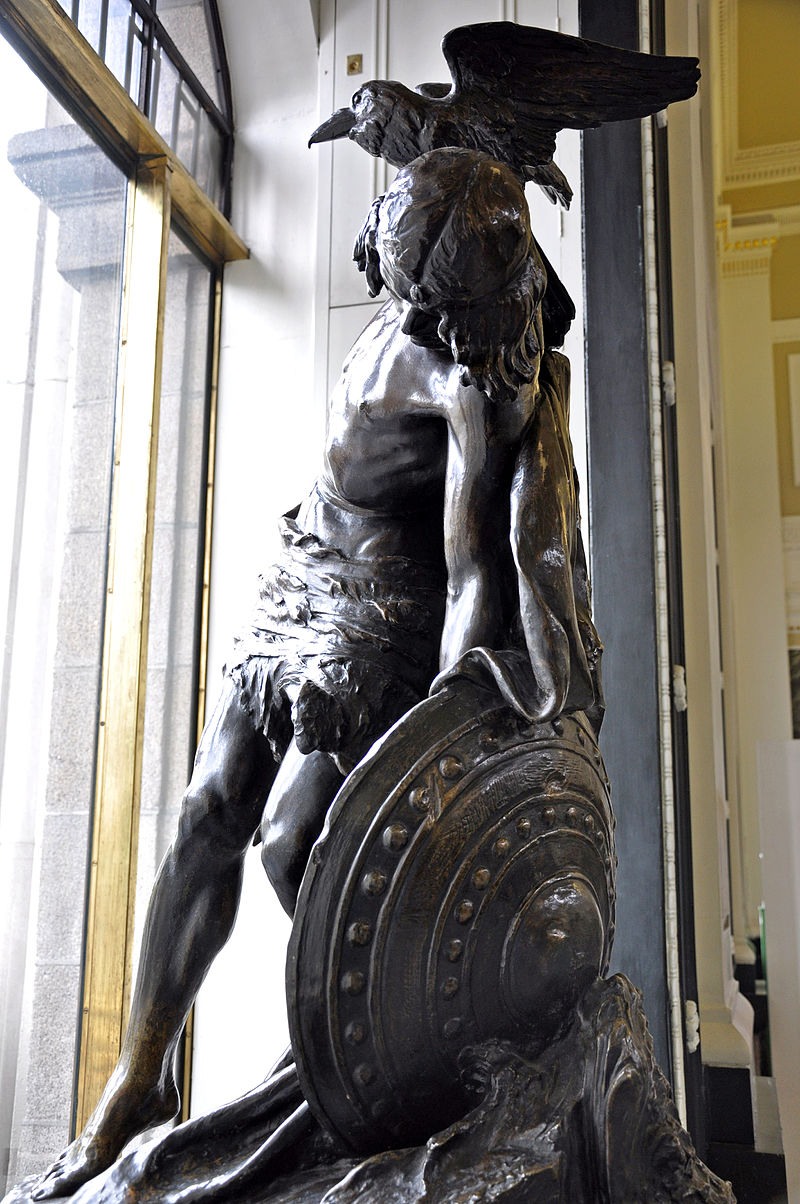
The Dying Cuchulainn
Oliver Sheppard was a respected Irish sculptor now remembered mostly for his 1911 work, The Dying Cuchulain. Sheppard, of Protestant background, was active in the Celtic Revival movement and sculpted The Dying Cuchulain in 1911, inspired at least in some respect by Lady Gregory’s work. In 1905 he sculpted a statute of a Wexford pikeman, recalling the United Irishmen Rising of 1798.
Eamon DeValera chose The Dying Cuchulainn to be placed in the GPO in 1935, in advance of the 20th anniversary of the Rising, describing the work as “a creation of Irish genius, symbolizing the dauntless courage and abiding constancy of our people.”
Stepping gingerly into the crisp mid-Atlantic surf earlier this month, I was met and abruptly bowled over by one of those inordinately strong breakers that one sometimes encounters at the beach. Getting up and advancing once again in the face of the relentless waves, I was reminded of Cū Chulainn, (sometimes “Cūhulain” or “Cūchulainn”) the great hero of Bardic Ireland, and his fight with the invincible sea, as depicted by William Butler Yeats in his 1925 Poem, Cuchulainn’s Fight with the Sea. While Cū Chulainn may not be a historical figure, his depiction in the pre-written, oral tradition of Ireland, as preserved in surviving monastic manuscripts and as revived and adapted during the Irish Literary Revival, is the subject of this month’s bulletin.
The oldest surviving written account of Cū Chulainn is found in the Book of the Dun Cow, (Lebor na hUuidre), currently in the possession of the Royal Irish Academy, which dates to the eleventh century. The manuscript was compiled at the monastery of Clonmacnoise, founded by St. Ciaran in 545. The manuscript contains a partial version of The Cattle Raid of Cooley, (Táin Bo Cuailngr) the most famous of the Cu Chulaiin tales, another partial recitation of which is found in the Yellow Book of Lecan (Leabhar Buide Leacain) compiled between 1391 and 1401 by the Mac Fhirbhisigh historians of Lecan (today Lackan) in County Sligo.
The Táin is an epic poem describing a first century war between Connacht, led by Queen Mebd (Anglicized as Maeve) and Ulster, led by Mebd’s ex-husband, King Conochbar. Mebd had her eyes on a prized bull of great renown, Donn Cuailnge, owned by one of Conochbar’s vassals, and there the trouble began. Most importantly for our purposes, the forces of Connacht, owing to a curse afflicting the army of Ulster, found that they were opposed in battle only by a teenaged Cū Chuliann, who as it turned out was opposition aplenty.
Cū Chuliann, originally named Setanta, was the son of King Conochbar’s sister and is perhaps the son of Lugh, Celtic god of the sun. Setanta, when still a boy, was invited by his Uncle Conochbar to a feast at the house of Culann, whose house was guarded by a fearsome hound. Arriving late, Setanta was set upon by the dog and killed it, despite his tender age. Being a lad of great honor, Sentana offered to take the place of the dog, and was thereafter known as Cū Chulainn (“hound of Culann”). Cū Chulainn is trained as a warrior and then engages in many great feats of strength and valor in the Táin and other tales, ultimately meeting his end years later when, in mortally wounded, he lashed himself to a great stone to be able to face his oncoming enemies.
Cū Chuliann as a character figured prominently in the Irish Literary Revival of the late 19th and early 209th century.
Yeats alone published works featuring Cū Chulainn no less than seven times, beginning with The Death of Cuchulainn in 1892 and ending with Cuchulain Comforted, in 1939. Lady Gregory, Co-founder of the Abbey Theater with Yeats, published Cuchulainn of Muirthemme: The History of the Men of the Red Branch of Ulster, in 1902. In his preface to Lady Gregory’s translation, Yeats wrote: “I think this book is the best that has …ever come out of Ireland: for the stories which it tells are a chief part of Ireland’s gift to the imagination of world.”
The notion that Ireland had a rich and ancient literary tradition of its own contributed to the sense of national identity that informed and inspired the men and women of 1916 and Cū Chuliann soon became a symbol of Irish Nationalism. Yeats, writing in the preface to Lady Gregory’s 1904 publication, Gods and Fighting Men, explicitly made the connection: “One remembers indeed that when the farming people and the labourers of the town made their last attempt to cast England out by force of arms they named themselves after the companions of Finn.” (Fenians). In one of his own works, a poem entitled The Statues, Yeats cements the association with the lines: “When Pearse summoned Cuchulain to his side / What stalked through the Post Office? What intellect, / What calculation, number, measure, replied?”
During Easter Week, 1935, as noted elsewhere in this Bulletin, Oliver Sheppard’s sculpture, The Dying Cuchulain, was unveiled at the GPO as a memorial to the men and women of 1916